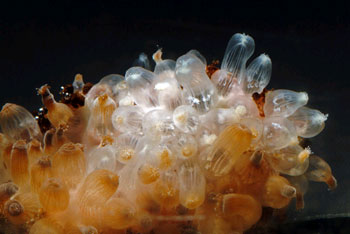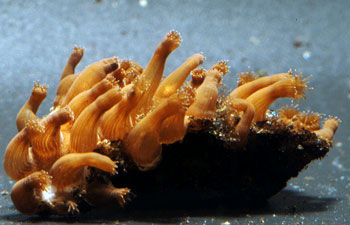Some corals may survive acidification caused by rising CO2
Some corals may survive acidification caused by rising CO2 levels
mongabay.com
March 29, 2007
Several studies have shown that increased atmospheric carbon dioxide levels are acidifying the world’s oceans. This is significant for coral reefs because acidification strips carbonate ions from seawater, making it more difficult for corals to build the calcium carbonate skeletons that serve as their structural basis. Research has shown that many species of coral, as well as other marine microorganisms, fare quite poorly under the increasingly acidic conditions forecast by some models. However, the news may not be bad for all types of corals. A study published in the March 30 issue of the journal Science, suggests that some corals may weather acidification better than others.
Israeli biologists Maoz Fine and Dan Tchernov found that some stony corals can survive increased acidity by morphing into soft-bodied polyp forms. The corals produce hard skeletons again once pH level returns to normal.
The research helps explain when some corals disappear and reappear on the fossil record. As soft-bodied polyps, corals will not leave recognizable fossil remains.
Despite these findings, Fine and Tchernov warn that decreasing ocean pH will cause profound changes to most coral species, degrading overall coral reef health and the systems the ecosystems afford mankind.

A soft-bodied stony coral after exposure to acidified experimental conditions. Under relatively high temperatures, these corals may lose their algal symbionts and become pale (bleached) or even transparent. [Image courtesy of A. Briestien]
Anemone-like stony coral after exposure to acidified experimental conditions. While the soft body coral survives, reproduces and grows bigger than usual, it loses its calcareous skeleton. [Image courtesy of A. Briestien] |
“It is important to note that although survival as soft bodies allows corals to persist, substantial decalcification of reefs will cause major changes to the structure and function of coral reef ecosystems and the services they provide to human society,” the authors write.
The suggestion that some corals can survive acidification is not new, though research definitely showing that they can take a soft-bodied form is novel. Prior studies indicate that some corals are capable of persisting through periods of acidification by building their calcium carbonate skeletons using calcite instead of aragonite. Scientists led by Justin Ries, a marine geologist at Johns Hopkins University, detailed the process in a paper published last year in Geology.
At the time, Ries said that corals “switch in response to decreases in the ratio of magnesium to calcium in seawater.”
More on coral
Corals are tiny animals that live in colonies and derive nourishment and energy from a symbiotic relationship with zooxanthellae algae known as dinoflagellates. Coral reefs are formed over the course of thousands of years as limestone skeletons constructed by corals accumulate and form a structural base for living corals. Previous studies indicate that is takes roughly a thousand years for a reef to add a meter of height. Individual corals are capable of faster growth — about one meter every hundred years — but wave action and other forms of disturbance moderates overall reef growth.
Scientists have expressed a great deal of concern over the potential impact of climate change on coral reef ecosystems. Both increasingly levels of acidity, which reduce the ability of coral to generate their main structural material, and higher sea temperatures, which can cause “bleaching” or expulsion of the symbiotic algae that enable corals to feed, are cited as the primary risks to reefs in a world of higher atmospheric carbon dioxide levels. The articles below provide more detail on these concerns.
CITATION: Maoz Fine and Dan Tchernov (2007). Scleractinian Coral Species Survive and Recover from Decalcification. Science 315: 1811.
Related articles
Carbon dioxide levels threaten oceans regardless of global warming. Rising levels of carbon dioxide will have wide-ranging impacts on the world’s oceans regardless of climate change, reports a study published in the March 9, 2007, issue of the journal Geophysical Research Letters. The study, authored by Ken Caldeira from the Department of Global Ecology at the Carnegie Institution at Stanford University and Long Cao and Atul Jain of the University of Illinois, shows the increasing absorption of carbon dioxide is acidifying global oceans, putting sea life at risk.
Some corals can adapt to ocean acidification. While scientists warn that increasing ocean acidity will doom marine animals that build skeletons and structural elements out of calcium carbonate, new research has found that corals can change their skeletons, building them out of different minerals depending on the chemical composition of the seawater around them. The finding could have significant implications for the global marine biodiversity when concentrations of carbon dioxide are growing in the world’s oceans. Justin Ries, a marine geologist at Johns Hopkins University, and his collaborators note “this is the first known case of an animal altering the composition of its skeleton in response to change in its physical environment.”
Coral reefs decimated by 2050, Great Barrier Reef’s coral 95% dead. Australia’s Great Barrier Reef could lose 95 percent of its living coral by 2050 should ocean temperatures increase by the 1.5 degrees Celsius projected by climate scientists. The startling and controversial prediction, made last year in a report commissioned by the World Worldwide Fund for Nature (WWF) and the Queensland government, is just one of the dire scenarios forecast for reefs in the near future. The degradation and possible disappearance of these ecosystems would have profound socioeconomic ramifications as well as ecological impacts says Ove Hoegh-Guldberg, head of the University of Queensland’s Centre for Marine Studies.
This article uses quotes and information from a University of Miami Rosenstiel School of Marine & Atmospheric Science news release and previous mongabay.com articles.
